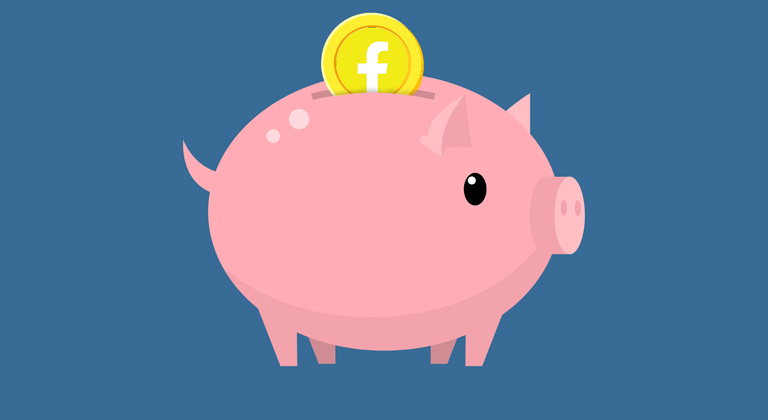Facebook book advertising on a shoestring budget
Book advertising has become an essential step to success, and when done right and with a desirable product, a bigger budget will lead to higher rewards and a faster path to success. But not everyone can afford to spend large amounts on ads, especially when just getting started. That doesn’t mean they should be ignored completely, though. There is still value in running small budget campaigns, and Ginger is offering up a few suggestions on the best ways to spend those dollars to get the most value in return.
I recently blogged about how you need to have courage when you start advertising your book – and I specifically called out the temptation to start a $5 a day advertising campaign as ineffective, and ultimately unprofitable.
However, what happens when you’re a brand new author and you don’t have $30 a day to spend promoting your book? How can you make an impact on Facebook when you don’t have a massive advertising budget to draw from?
So, I’m going to contradict my (admittedly still sound) advice from that previous blog and let you know of a few strategic advertising campaigns that you can put together which won’t break the bank – and will hopefully lead to an increase in sales which will start you on the path towards having a real, grown-up book advertising budget to work with!
Figuring out your budget
The first thing you need to do when scraping together the pennies to start advertising on Facebook is to assemble your forces – and by that, we mean money. As Sun Tzu said in The Art of War: “Whether to concentrate or to divide your troops, must be decided by circumstances.”
I used the example of $5 a day as a budget to work with – but instead of limiting it to that, think of it as $150 to spend within a single month. This means you could spend it all rapidly, on one targeted campaign, or stretch it out across the entire month.
Depending on what you’re looking to achieve, this can enable you to make a significant impact even with an insignificant budget – as long as you plan it right.
Define your goal
That’s where this part of the equation comes in – deciding what it is you want to achieve. Most authors would simply say “I want to sell more books” but that’s a tricky proposition if you’re limiting yourself to just $5 a day in advertising. Digital books are notoriously ‘low margin’ products, which means the profit margin you have to work with is extremely limited. A $3.99 book will provide its author with about $3 in royalties, so if you’re spending $5 a day on advertising, you’ll need to sell at least two books (or get the equivalent in Kindle Unlimited page reads) not to be losing money.
At $0.15 a click, that means you need to sell a book within just 10 clicks to break even – and even for the most accomplished and established author, that isn’t easy.
Not to mention the fact that even if you achieve this goal, it means you’re selling two books. Just two. This is not how bestsellers are made.
So start thinking about other goals – other than just profitable book sales. A good suggestion could be promoting a period in which you’re giving your books away for free as part of a Kindle Select free promo.
Promoting a free book
I use the 5-day free promo tactic for every book I launch, and I’ve found using Facebook ads to bump up the number of downloads I get to be very, very powerful.
Instead of planning to spend $5 a day for an entire month, consider spending $50 a day promoting your ‘free’ book for three days. In addition to reaching a ton more people, you’ll also have the perfect sales message: FREE! This means you might find you get dozens more downloads than you would have gotten from paid sales.
Obviously, the downside to this is that you’re ‘losing’ money – you’re not going to see a return on investment for that $150 because you’re not promoting something that people pay for.
However, I’ve generally found that I’ll get my $150 back in the days and weeks following the promotion because the additional copies of my books I’ve given away have shoved my title into the Also Bought section of dozens (or hundreds – even thousands) of other titles.
Sadly, Amazon has moved the Also Bought ribbon to the bottom of the product page, so it’s not as effective as it once was, but this tactic will end up providing you with significantly more paid sales than a single $5 a day advertising campaign would.
Getting your book ranked
Another powerful book advertising tactic to use when you have a limited budget is to concentrate your forces in an attempt to get your book ranking in the Top 100 for any of the categories it’s in. This can mean top-loading your ad spend to get more sales in a shorter period, as well as stacking other promotions, newsletters and social media campaigns at the same time. All of this is for the purpose of moving your book up in the category ranks.
I’ve written before about how adding book categories can make your book massively more visible on Amazon – and significantly easier to get ranking in some of those categories.
To get into the Top #10 of the Books > Mystery, Thriller & Suspense > Thrillers & Suspense > Crime category, you’d need to sell an estimated 509 books in a single day (according to the folks over at Publisher Rocket.)
To get to the Top #10 of Books > Literature & Fiction > Action & Adventure > Mystery, Thriller & Suspense > Thriller & Suspense however, you’d need just one. Yes, a SINGLE sale can get you into the Top 10 list because the gap between the #1 book (an estimated #434 in Amazon’s sales rank) and the #10 book (#166,715) is so vast.
Your thumbnail would include the #Bestseller flair either way – and that can have a massive impact on your sales.
These days, it doesn’t take long for other titles to knock you off that coveted position (unless you keep advertising) but it can be a much more powerful way to make an impact than a drip-drop-drip of $5 a day spending.
Building a subscriber base
Tell you what, though. I’ve had one campaign running since 2015 that has a daily budget of just $5 – it’s the one I use to get new subscribers for my mailing list.
I offer a free download of the first 3 books in my romance catalog for readers who sign up to my mailing list, and then I spend $5 a day promoting that offer. Each and every day I’ll receive up to 5 new subscribers – and because I now have their email address, they’ll end up paying that investment back because they’re more likely to buy my future books when I promote them with my newsletter.
This is one occasion in which a $5 a day budget does work extremely well – slowly building up your mailing list, so you can deploy dozens (hundreds) of readers on launch day, when you want to get some reviews, or if you’re pushing a free book.
Building a subscriber base is an investment – and it’s one of those things in which you’ll see a positive return on investment even with a paltry daily advertising spend.
Just to see if your book sells!
The final way to make the most of a $5 a day Facebook advertising campaign is just to see if it works!
When I started publishing books under my own name, instead of my established penname, I was starting off with nothing. I didn’t have a huge subscriber base, a massive back catalog, or even that many reviews for my books. The fact was that I was in no position to effectively make an impact with just $5 a day budgeted to spend.
However, I did it anyway. I posted a $5 a day campaign driving potential readers directly to my product page on Amazon.
Why?
Because I saw that people clicked on it, and a few of them bought my books. As a brand new author starting out, that can feel amazing – and because you probably haven’t given up your day job yet, it can all be accomplished by simply skipping your daily Starbucks, or some other minor sacrifice to find that $5 to spend.
And while you’re not going to build a sustainable writing career that way, you will end up building some infrastructure that can serve you later. For me, each of those daily clicks were providing information to Facebook about who would respond to my ads. That meant when I had a ‘big boy’ budget to spend, I could generate a lookalike audience based off the people who’d responded to my $5 ad. It took a while to generate enough people to do that – but $5 a day every day will eventually deliver.
It also led to a trickle of reviews and occasional sales, plus the odd newsletter subscriber, so even though it wasn’t ‘profitable’ I was seeing some progress being made and it encouraged me to keep going.
Tweaking audiences, copy, and creative also helped. I thought of the $5 a day as the price of kicking the tires and testing things out – so when I finally decided to spend a ‘real’ budget, I did so with a much better starting position than I would have done otherwise.
I know I’ve argued against spending just $5 a day on book advertising in general – but if that’s all you’ve got, and you can afford to lose it, it’s the start of something. Something will always be a better starting position than nothing.
In Conclusion
You’re not going to find yourself on the New York Times Best-Seller list by spending $5 a day on FB book advertising. However, you can still end up getting some value out of it. In terms of subscribers, that can mean some real value (such as repeat customers buying your future books) that justifies your efforts.
I still believe saving up and hitting advertising with a significant budget is the fastest way to advance your career – but everybody’s got to start somewhere, and as long as you have specific goals in mind, with tangible figures to define success or failure, then you’ll find that $5 can stretch a lot further than you think.
Remember, if you’re looking to get your head around advertising, Hidden Gems offers 1-to-1 consulting to help you shortcut the expensive learning process – including how to implement all the ideas outlined above.












The problem with this ‘category’ advice is that there are NO categories such as you advise to choose – you can write to KDP all you want, they will continue to advise you to pick from the ‘listed and existing’ categories – which are:
FICTION > Mystery&Detective> and a list of choices
or FICTION > Thrillers> and a shorter list of choices
It would be much more useful to authors to actually give an advice that is practical – and how to get your book placed in a non-listed category – or how to persuade KDP to put it in a category you devise on your own and which is unlike anything that exists on their list.
In conclusion, it’s a proven fact that nothing short of $15,000 spent on advertising with one of the super-charged ad agencies will get you that #1 bestseller or New York Times Bestseller stamp – nothing, but serious advertising money will help an author who has less than thousands a month to advertise and advertise everywhere, in addition to advertising five times on BookBub in a single week.